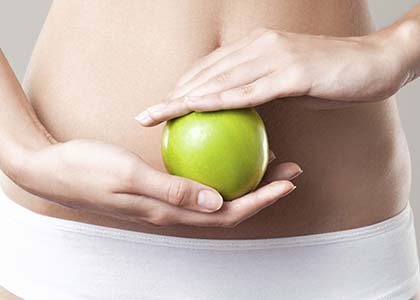
Nutritionist-Approved: PCOS Diet Tips
By Isabel Smith, MS, RD, CDN
Polycystic Ovary Syndrome (PCOS) is a common health issue that affects the female endocrine system and causes enlarged ovaries that contain small collections of fluid called follicles. Symptoms of PCOS can include elevated blood sugar due to excess insulin production, difficulties with weight management and skin health, excess hair growth, difficulties with fertility and more.
While the cause of PCOS is largely unknown, there are certain treatment approaches that may help to at least promote overall health and symptom management and two of them include diet and exercise that can help to promote skin health, weight management and overall health.
When it comes to diet for PCOS, there are a few general key eating tips:
- Skip the processed stuff that includes candies, soda, boxed foods with additives – and other things of the sort
- Include more nutrient and fiber-rich plant foods like fruits and vegetables
- Choose healthy fats like avocado and nuts for satiety, skin health and anti-inflammatory properties
- Include lean protein both plant and organic animal-based to help promote satiety
- Drink plenty of fluids; that includes mostly water and cut out artificial sweeteners and ingredients in beverages like teas, sodas, etc.
When it comes to planning foods and diet for PCOS, there are a few key nutrients that stand out besides of course those that come in vegetables and fruits – that should make up most of our plate (50-75% in total):
-
Healthy Fat
Healthy fat is another key nutrient for overall health, anti-inflammation in the body, and it also plays a role in helping to promote satiety and balanced blood sugar as well. Healthy fat can be found in plant based oils like olive oil, avocado and nuts.
-
Fiber
Fiber helps to slow digestion that can help to prevent blood sugar spiking. It’s also good for promoting satiety that is key for controlling appetite and intake. Fiber is found in plant foods including dark leafy greens, beans, whole grains, etc.
-
Protein
Protein is a key nutrient for balancing blood sugar, promoting satiety and also for helping to promote weight management as well. Plant based protein sources include tofu and edamame, nuts and nut butters, and beans as well.
6 Tips for Eating and Juicing for PCOS:
- Eat small and frequent meals.
This helps to promote healthy blood sugar, energy and can also help with weight loss. Choose to include foods with at least one of the three key nutrients at each meal and snack, for example:- Nuts for a snack
- Add avocado to a salad or sandwich on whole grain bread
- Include organic/minimally processed turkey or chicken in a sandwich
- Drink juice.
One of the best ways to get more nutrients into our bodies is by juicing, which for some with PCOS may come by surprise. Because juices are often thought to have too much sugar, many will avoid it. It’s true that a juice with too much sugar isn’t a great idea for anyone with PCOS- and on a regular basis for anyone in general, really; instead, keep the fruit low, and the vegetables high- choose juices with 10-20% fruit and 80-90% vegetables, like these:
- Ease off the caffeine.
This may also cause some surprise, but caffeine may make us a little less insulin sensitive, and (for anyone, really) especially with PCOS, we want to make our bodies more insulin sensitive. Instead of caffeinated beverages,- Choose hot water with lemon and ginger to start the day
- Try caffeine-free teas, like dandelion tea that has a rich coffee-like feel
- Just drink more water!
- Get blending.
Smoothies are also a great way to get in more nutrients, just like juicing is. Like juicing, smoothies can quickly be a place for extra sugar, so beware of this, and add just one serving of fruit, and loads of vegetables in addition to a healthy fat or protein like 1-2 teaspoons coconut oil, 1/3 avocado, or a scoop of plant-based protein like this one.
- Portion control the starchy stuff.
This is important for almost everyone as well, but starches can certainly find their way onto our plates and into our glasses easier than we realize. Focus on trying to keep the starchy stuff (corn, potatoes, pasta, rice, peas) to about 25% of the plate, and to make it more delicious, try these smart swaps for classic starchy dishes:
- Get Your Vitamin D checked.
Vitamin D has been shown to be associated with insulin resistance and many people are unknowingly deficient, so next time you go to see your doc, get a blood check and appropriate supplementation as needed; read more about vitamin D here.